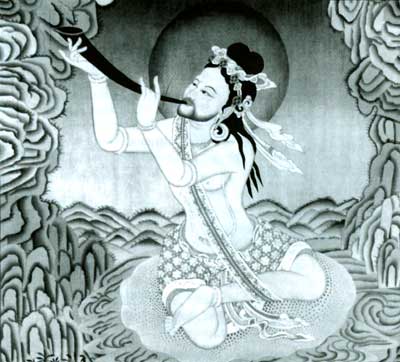
Buddhist Symbolism in Tibetan Thangkas
The Story of Siddhartha and Other Buddhas Interpreted in Modern Nepalese Painting
by Ben Meulenbeld
Weiser Books: Maine, 2001
112 pp.; $19.95 (paper)
This book is an introduction to the art of the Tibetan scroll painting, or thangka—literally, “something that can be rolled up.” The author comments on thirty-seven thangkas, reproduced here in full color, which take us through the life of the Buddha.
He also explains how to understand the symbolism that identifies the many figures of veneration of the Vajrayana tradition—from Padmasambhava and Naropa, through various dakinis and yoginis, to the Kalachakra Mandala.
Eight Mindful Steps to Happiness:
Walking the Buddha’s Path
by Bhante Henepola Gunaratana
Wisdom Publications: Boston, 2001
268 pp.; $16.95 (paper)
Bhante Gunaratana’s earlier book Mindfulness in Plain English was first published in 1993; even though a spate of books for beginners has glutted the market since that time, it has retained its status for being among the very best. His new book on the Buddha’s Eightfold Path is the much-awaited sequel and serves the reader just as well. Bhante Gunaratana’s forte is his presentation of clear, intelligent insight into the most basic teaching in a voice that is well acquainted with the West. The instructions, honed for contemporary Western ways, make this book another exceptional example of how profound a simple and accessible book can be.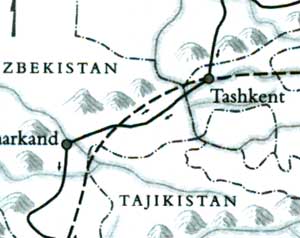 Ultimate Journey:
Ultimate Journey:
Retracing the Path of an Ancient Buddhist Monk Who Crossed Asia in Search of Enlightenment
by Richard Bernstein
Alfred A. Knopf: New York, 2001
352 pp.; $26 (cloth)
In the early seventh century, a Chinese Buddhist monk named Hsuan Tsang left his home in Ch’ang-an, China, and set out across Asia, all the way to India, where the Buddha had lived and taught more than a thousand years before. He traversed harsh desert and tall mountains “on camel-back, elephant-back, or on foot,” ultimately crossing nearly five thousand miles in search of the Law, “the original classics of Buddhist thought,” and to settle what he called “the perplexities of my mind.” He returned safely, a mere sixteen years later.
Ultimate Journey is the story of a twentieth-century reenactment of this ancient quest. Richard Bernstein, a writer on leave from the New York Times, undertook to retrace the steps of Hsuan Tsang, juxtaposing his experiences with those of his fabled predecessor, reconstructing the marvels of this ancient route.
He travels by jeep and by motorcycle-rickshaw, meeting cranky Maharajas, Pakistani soldiers, and numerous traveling monks. Everywhere, the past infiltrates the present. In Bodhgaya, site of the Buddha’s enlightenment, he sees a banner announcing “Coca-Cola welcomes His Holiness the Dalai Lama.”
Although this book is notable for both its historical depth and its tales of adventure, Bernstein does not neglect to honor Hsuan Tsang’s power of spirit, his search for illumination. The author finds himself reflecting deeply on the nature of truth as Hsuan Tsang sought it, making of this journey his own pilgrimage.
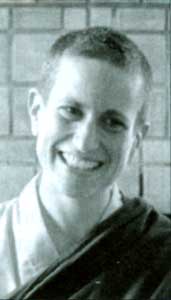
Buddhism for Beginners
by Thubten Chodron
Snow Lion Publications: Ithaca, N.Y., 2001
160 pp.; $12.95 (paper)
Ven. Thubten Chodron, an American-born nun in the Tibetan tradition, wrote Buddhism for Beginners to explain the fundamentals of Buddhism to students who had requested to hear about the teachings “in everyday English . . . without a lot of Pali and Sanksrit terms.” She answers basic questions—Who is the Buddha? What is meditation? What is karma?—directly, with examples from daily life. Aside from a chapter on the Vajrayana tradition, the teachings presented are nonsectarian. Although the book consists of questions and answers, Ven. Chodron reminds readers to continue to reflect on these questions, to “hold” them, even when an answer has been given, so that the teachings may be better integrated into their lives and practice.
The Iron Flute
100 Zen Koans
by Nyogen Senzaki and Ruth Strout McCandless
Tuttle Publishing: Boston, 2001
153 pp.; $14.95 (paper)
The Iron Flute is a collection of 100 koans, or teaching stories, that were used by the great Zen patriarchs of T’ang and Sung China. The original version of this presentation was compiled by Genro, an eighteenth-century Japanese Zen master. The English translation is by Ruth Strout McCandless and Nyogen Senzaki, the first Zen master to take up residence in the West. Originally published by Tuttle in 1964, The Iron Fluteheld an iconic allure for the first wave of Zen enthusiasts. Enhancing this new edition are some short essays by and about Nyogen Senzaki and an instructive introduction by Steve Hagen. Nyogen said of himself that he was like a mushroom, with no roots, no flowers, and no seeds, and wished, at the end, to blow away like dust. Fortunately for us, and with Tuttle’s help, this has not happened.
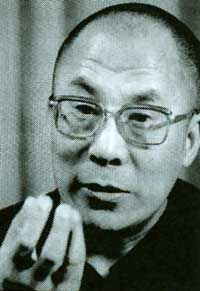
Dzogchen
The Heart Essence of the Great Perfection
Teachings given in the West by His Holiness the Dalai Lama
Foreword by Sogyal Rinpoche
Translated by Geshe Thupten Jinpa and Richard Barron (Chokyi Nyima)
Edited by Patrick Gaffney
Snow Lion Publications: Ithaca, N.Y., 2001
271 pp.; $24.95 (cloth)
As Sogyal Rinpoche points out in his foreword, one of the characteristics of His Holiness the Dalai Lama is “his all embracing attitude towards all Buddhist traditions, indeed towards all faiths.” The Dalai Lama brings this vast knowledge and erudition to his explanation of Dzogchen, which he calls “the pinnacle of all vehicles.” These extraordinary teachings on Dzogchen, also translated as the “Innate Great Perfection,” were given by His Holiness to Western students between 1982 and 1989. He offers here not only luminous insight into the heart of spiritual practice, but so too practical advice on how to bring such teachings into daily life. His humor adds a warm grace note throughout. The book also includes an afterword by the late Nyoshul Khenpo Rinpoche entitled “A Gift to the World.” In his introduction to this teaching, Sogyal Rinpoche says of Nyoshul Khenpo, “No one who met him can ever forget his extraordinary presence or the spirit in which he taught, which embodied so perfectly the fathomless ease and vastness of Dzogpachenpo.” Clear, easy to understand—Dzogchen: The Heart Essence of the Great Perfection is a perfect book for our times.
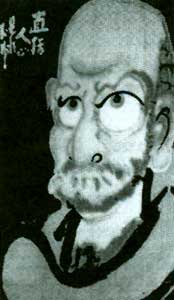 Secrets of the Blue Cliff Record
Secrets of the Blue Cliff Record
Zen Comments by Hakuin and Tenkei
Translated by Thomas Cleary
Shambhala Publications: Boston, 2000
354 pp.; $29.95 (cloth)
The Blue Cliff Record, a classic work of Zen Buddhism, is a collection of one hundred traditional citations and stories known as gongan in Chinese and koan in Japanese and English. These koans were originally selected by the Chinese Zen master Hsueh-tou (980-1052); the work was later taken up by another Zen master, Yuan-wu (1063-1135), who added his own introductions and commentaries to both the original koans and Hsueh-tou’s verses. The complete English text, translated from the Chinese, has been available for nearly a quarter century, but authentic traditions of commentary have been hard to find—until this fluidly translated work, which includes commentaries by two of the greatest Zen masters of early modern Japan, Hakuin Ekaku and Tenkei Denson. Their words shine light on this deep and extraordinary work.
Encompassing heaven and earth, transcending holy and ordinary, pointing out the subtle mind of nirvana on the hundred weeds, determining the pulse of Zen practitioners in the jungle of shields and spears—tell me, due to whose power can one be this way?
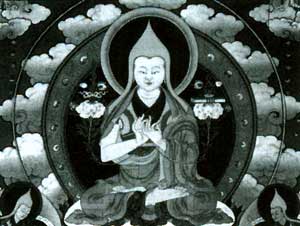 The Great Tratise on the Stages of the Path to Enlightenment
The Great Tratise on the Stages of the Path to Enlightenment
Lam Rim Chen Mo
by Tsong-Kha-Pa; Joshua W. C. Cutler, Guy Newland, Eds.
Snow Lion Publications: Ithaca, N.Y., 2001
434 pp.; $29.95 (cloth)
This recent English translation of the first volume of Jey Tsong-kha-pa’s Lam Rim Chen Mo, one of the greatest of all masterworks of sacred literature, makes the work as timely and radiant as ever. One of Tibet’s most renowned philosophers, and founder of the Gelug school of Tibetan Buddhism, Tsong-kha-pa completed The Great Treatise in 1402 C.E. Treasured for its clarity and breadth, it is one of the principal works of Mahayana Buddhism. Focusing on the development of bodhicitta, the spirit of enlightenment, the work condenses the exoteric sutra scriptures into a form that is easy to follow, and scholars and practitioners alike have relied on its authoritative presentation for centuries. All the practices necessary for cultivating bodhicitta are underscored within it. Such chapters as “The Greatness of the Teaching,” “Relying on the Teacher,” “The Precepts of Refuge,” “The Varieties of Karma,” and “The Origin of Suffering” are discussed with immense wisdom and detail. An indispensable work for Buddhists of all stripes.
Cultivating the Empty Field
The Silent Illumination of Zen Master Hongzhi
by Taigen Dan Leighton
Tuttle Publishing: Boston, 2001
119 pp.; $16.95 (paper)
Hongzhi was a twelfth-century Chinese Zen master, credited with being the first to describe the practice of silent illumination—or as Zen students know it: “just sitting.” This revised translation of the renowned teacher’s practice instruction and religious verses is accompanied by a substantial introduction. Here Leighton traces Hongzhi’s life, explores his use of nature as metaphor, and outlines the Master’s teaching of ultimate nondualistic illumination, later elaborated in Japan by Zen Master Dogen.
As for the verses themselves, and the practice instructions, Leighton says they “evoke the actual experience of enlightened, illuminating awareness.”
Swallowing the River Ganges
A Practice Guide to the Path of Purification
by Matthew Flickstein
Wisdom Publications: Boston, 2001
180 pp.; $16.95 (paper)
Swallowing the River Ganges is intended as a contemporary version of the Visuddhimagga, or Path of Purification, the ancient commentary on the Buddha’s core teachings. The book’s title refers to an episode, some years ago, when the author queried Korean Zen Master Seung Sahn about what was on the venerable teacher’s mind. “You’ll understand what I am thinking when you can swallow the River Ganges,” he replied.
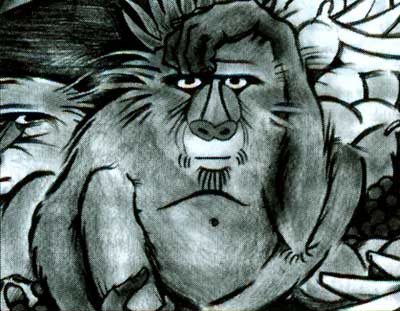
Kindness
A Treasury of Buddhist Wisdom for Children and Parents
by Sarah Conover
Eastern Washington University Press: Spokane, 2001
162 pp.; $19.95 (paper)
Too many Buddhist books for children are solemn, moralizing, and use archaic language. Kids are a tough audience, not likely to sit still through a lesson in story’s clothing—they like color, details, dialogue. Kindness is a read-aloud book peopled with monks, samurai, talking lions, and the Buddha in several incarnations. Sarah Conover has a fine ear for what kids find funny—a demon named Monster Sticky Hair, a beetle trapped under a pile of elephant dung—and she tells a good tale. For adults she provides a key at the back of the book, citing the derivation of canonical stories and Jataka tales, as well as the scriptural sources for the quotes she has interspersed among the stories. Illustrations by Valerie Wahl find a perfect home here.